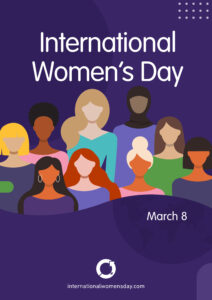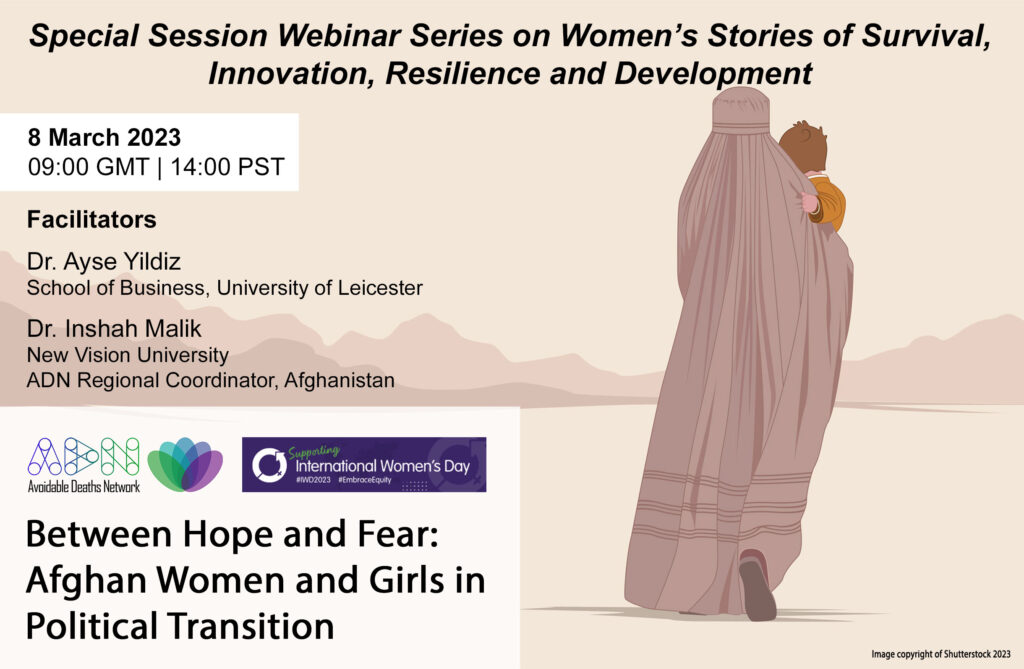By Mr. Tom Caley and Dr. Madhulika Sahoo
 On 8th March, the world celebrates International Women’s Day (IWD) with this year’s campaign theme as #EmbraceEquity. The IWD 2023 #EmbraceEquity theme campaigns for gender equity; the latter understanding “equal opportunities are no longer enough” and can in fact be exclusionary rather than inclusive (Hogan, 2023). With gender equality as the end, gender equity is seen as the means to enable it. Equity implies proactively intervening where groups are inherently marginalised and weakened by the status quo.
On 8th March, the world celebrates International Women’s Day (IWD) with this year’s campaign theme as #EmbraceEquity. The IWD 2023 #EmbraceEquity theme campaigns for gender equity; the latter understanding “equal opportunities are no longer enough” and can in fact be exclusionary rather than inclusive (Hogan, 2023). With gender equality as the end, gender equity is seen as the means to enable it. Equity implies proactively intervening where groups are inherently marginalised and weakened by the status quo.
IWD supports the United Nations Sustainable Development Goal 5 (Gender Equality), to “achieve gender equality and empower all women and girls” (United Nations Department of Economic and Social Affairs, no date). Gender equality is more than an issue of fairness. In 2011, then US President Obama stated: “history shows that when women and girls have access to opportunity, societies are more just, economies are more likely to prosper, and governments are more likely to serve the needs of all their people” (The White House, 2011). Lately, UN Secretary-General Antonio Guterres frames gender equality as “a fundamental human right, and a solution to some of our greatest global challenges” (cited in Whiting, 2023). In a statement delivered to the General Assembly this February 6th, Guterres promised ‘redoubled’ efforts on representation gaps within business and government and a rebalancing of equality in the realms of science and digital technology (Secretary General, 2023).
Gender perspectives on disaster deaths
Gender equality is one of the UN’s cross-cutting goals (Zaidi and Fordham, 2021), and setbacks to progress provide pathways to understanding avoidable deaths in disasters. Vulnerability perspectives hold that disasters affect different people in different ways. Indicating women are more exposed to short- and longer-term impacts (Cannon, 1994; Ray-Bennett, 2018). The 2015 Sendai Framework for Disaster Risk Reduction (SFDRR) also makes reference to the modalities in which women experience increased vulnerability in disasters (Zaidi and Fordham, 2021) and calls for disaggregated data collection for risk reduction and analysis from a gender perspective.
Particularly in developing countries, existing social norms may expose women to greater risk. For example, studies show dress codes such as the saree or burqa were found to inhibit movement for women escaping a cyclone in Bangladesh (Neumayer and Plümper, cited in Ray-Bennett, 2018), women were less likely to have been taught to swim than men (Eklund and Tellier, cited in Ray-Bennett, 2018) and the onus of child care can increase risk in the disaster response phase (Eklund and Tellier; Neumayer and Plümper, cited in Ray-Bennett, 2018).
The SFDRR, as a consensus global policy agreement, is focused upon reducing loss and damage from disasters rather than addressing the underlying causes of vulnerability. Given the likelihood that disasters may cause more negative outcomes for women and girls (UNISDR, cited in Zaidi and Fordham, 2021). In this respect frameworks of the future might share more common pathways with the development agenda and SDGs (Zaidi and Fordham, 2021), recognising inherent disadvantages and enabling actions to rebalance in the interests of all members of society, including women. Furthermore, the regional level Sendai Framework is now emphasising an actionable framework on gender equality (Bargabha, 2021).
Recent setbacks
Gains made in gender equality have faced severe setbacks in recent times. On 16th September 2022, protests were sparked in Iran after 22-year-old Mahsa Amini died in the custody of the so-called ‘morality’ police (Askew, 2023). Arrested for allegedly not wearing a hijab correctly, the incident sparked demonstrations and violent crackdowns, with a reported 522 people killed and 20,000 people detained (Iran Human Rights Activists News Agency, cited in Askew, 2023). Since 2021 Afghanistan has reverted to life under the Taliban. Guterres notes that women and girls are now “exiles in their own country, banned from public life, with every aspect of their lives controlled by men” (Secretary General, 2023). In December 2022, the exclusion of girls from secondary schools was compounded by a banning of women from universities (Limaye, 2022).
Women continue to occupy more insecure jobs, are less able to increase their hours of paid work and may become the “shock absorbers” of poverty (Charlton, 2023). Such factors may explain why women earn just 80 cents on the dollar (USD) compared to their male counterparts, particularly among women of colour (Pipeline, 2023). Women are still underrepresented in the ‘STEM’ fields of Science, Technology, Engineering and Mathematics (Chellapa et al. 2022), a particular focus of attention for this year’s United Nations campaign.
ADN Special Sessions on women’s stories to #EmbraceEquity
In support of SDG #5 and to support the IWD #EmbraceEquity campaign, the Avoidable Deaths Network (ADN) and the Institute for Environmental Futures in collaboration with
 Auckland University of Technology’s Bringing Research into International Development and Global Equity (BRIDGE) Network, South Asia Alliance of Disaster Research Institutes (SAADRI) – Sri Lanka Chapter led by the University of Colombo, University of Leicester’s School of Business and Women Inspiration Network and the New Vision University will present four webinars in 2023.
Auckland University of Technology’s Bringing Research into International Development and Global Equity (BRIDGE) Network, South Asia Alliance of Disaster Research Institutes (SAADRI) – Sri Lanka Chapter led by the University of Colombo, University of Leicester’s School of Business and Women Inspiration Network and the New Vision University will present four webinars in 2023.
The Special Sessions webinar series focus on Women’s Stories of Survival, Innovation, Resilience and Development, from women under the most challenging of circumstances. These sessions are also designed to showcase women’s’ and girls’ agencies, as well as the challenges of coping and adaptation.
Join us to celebrate IWD on the 8th of March by attending the first session entitled Between Hope and Fear: Afghan Women and Girls in Political Transition.
References
Askew, J. (2023) Iran protests: What caused them? Are they different this time? Will the regime fall? Available at: https://www.euronews.com/2022/12/20/iran-protests-what-caused-them-who-is-generation-z-will-the-unrest-lead-to-revolution (Accessed 15 February 2023)
Cannon, T. (1994) ‘Vulnerability analysis and the explanation of ‘natural disasters’, in Varley, A. (ed) Disasters, Development and Environment. New York: John Wiley and Sons Ltd, pp. 13-30.
Charlton, E. (2023) This is why women are bearing the brunt of the cost of living crisis, according to research. Available at: https://www.weforum.org/agenda/2023/01/cost-of-living-crisis-women-gender-gap/ (Accessed 16 February 2023)
Chellappa, A. S., Sahoo, M., & Sahoo, S. (2022). ‘Gender inequality infiltrates the in silico modeling world’ in Nature Computational Science, 2(6), pp. 346-347.
Hogan, M. (2023). International Women’s Day 2023 will #EmbraceEquity for a better world. Available at International Women’s Day 2023 Will #EmbraceEquity For A Better World (portobelloinstitute.com) (Accessed 17 February 2023)
Pipeline (2023) An audacious goal: Achieving gender equity in our lifetime. Available at: What is Gender Equity and Why Does it Matter? | Pipeline Equity (Accessed 16 February 2023)
Ray-Bennett, N. (2018) Avoidable deaths. A systems failure approach to disaster risk management. Cham, Switzerland: Springer
Roy, K., Smith, D.G. and Johson, W.B. (2020). Gender equity is not zero sum. Available at: Gender Equity Is Not Zero Sum (hbr.org) (Accessed 16 February 2023)
Secretary General (2023) Secretary-General’s briefing to the General Assembly on Priorities for 2023. Available at: https://www.un.org/sg/en/content/sg/statement/2023-02-06/secretary-generals-briefing-the-general-assembly-priorities-for-2023-scroll-down-for-bilingual-delivered-all-english-and-all-french-versions (Accessed 15 February 2023)
The White House (2011) Statement by the President on the 100th Anniversary of International Women’s Day. Available at: https://obamawhitehouse.archives.gov/the-press-office/2011/03/08/statement-president-100th-anniversary-international-women-s-day (Accessed 15 February 2023)
United Nations Department of Economic and Social Affairs (no date) The 17 Goals. Available at: https://sdgs.un.org/goals (Accessed 15 February 2023)
Zaidi, R.Z., and Fordham, M. (2021) ‘The missing half of the Sendai framework: Gender and women in the implementation of global disaster risk reduction policy’ in Progress in Disaster Science, 10 (2021), pp. 1-7.
Bargabha, M. (2021). The Sendai framework and its gendered implementation. Available at: The Sendai Framework and its gendered implementation | UNW WRD Knowledge Hub (unwomen.org) (Accessed 20 February, 2023)
Additional Information
Mr. Tom Caley is the ADN Blog Writer and MSc candidate in Risk, Crisis and Disaster Management – University of Leicester.
Dr. Madhulika Sahoo is the ADN Editorial Manager and Assistant Professor, Department of Anthropology – Kalahandi University.


المديرية العامة لاعداد المعلمين والتدريب والتطوير التربوي. شكرًا لك..